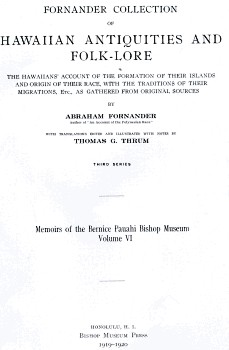 |
surfresearch.com.au
fornander : hawaiian antiquities, 1919 |
| home | catalogue | history | references | appendix |
|
It is a high precipice
where a man jumps from. If the man makes a skillful~ leap, touching the
water toes first, it is called iomo, which means "without splash."
(32)
Footnote 32.
The acme of skill
in leaping into the water, with Hawaiians, regardless of height, was to
enter the water feet first, with the least agitation of the water.
The Tahitians'
enjoyment of the sport was the reverse, for they delight to create the
greatest splash, to accomplish which they double their feet under them
in jumping from a height, so as to plump into the water with the greatest
possible commotion.
Diving headfirst
into the water is seldom if ever practiced by either race.
A long board is
hewn from the willwilli wood (34), four fathoms long, some three,
so on down to one fathom; the width is one yard.
Here are the
names of the boards and the surfs:
The board is alaia,
(35) three yards long.
The surf is kakala,
a curling wave, terrible, death-dealing.
The board is
olo,
(36) six yards long.
The surf is opuu,
(37) a non-breaking wave, something like calmness.
If there is no surf, invoke seaward in the following manner:
Arise, arise ye
great surfs from Kahiki,
The powerful
curling waves.
Arise with the
pohuehue,
(38)
Well up, long
raging surf.
When the surf
rises and breaks lay the board on.
The man has two
places to slide in the surf, the foam, which is within the curl, or the
end, which is outside the curl.
Footnote 35
Alaia is
the name given to a small, thin, surf board.
Footnote 36
Olo was
the large, thick, wiliwili surf board.
Footnote 37
Opuu, the blind-breaker
character of surf prevalent during calm periods.
Footnote 38
Hawaiians had
two methods of surf coaxing during calm weather, the general method being
for a swimming party to take several strands of the sea-convolvulus vine,
and swinging it around the head lash it down unitedly upon the water until
the desired undulating waves were obtained, at the same time chanting for
a response to their effort. (Hawaiian Annual, 1896.)
Surf riding has
a wider range of sport than shown above, for canoe surfing is also very
generally practiced, and occasionally body surfing.
This requires
strong, expert swimmers to attain sufficient momentum to ride in on the
surf without a board or other support.
This, termed
kaha
nalu, is still practiced.
He alaia ka papa
(ekolu iwilei ka loa).
He kakala ka
nalu - he nalu poi, he aaka, he make.
He olo ka papa
(eono iwilei ka loa).
He opuu ka nalu,
he nalu poi ole, he alaneo ke ana.
Ina aohe nalu, alaila, kahea aku i kai, penei e hea ai.
Ku mai! Ku mai!
Ka nalu nui mai Kahiki mai,
Alo poi pu! Ku
mai ka pohuehue,
Hu! Kaikoo loa.
I ke ku ana o
ka nalu a hai, alaila, hoomoe ka papa, elua wahi a ke kanaka e halo ai
i ka nalu.
0 ka hua maloko
ia o ka nalu, o ka lala mawaho ia o ka nalu.
 |
Fornander Collection of Hawaiian Antiquities and Folk-Lore. With Translations Edited and Illustrated with Notes by Thomas G. Thrum. Bernice Pauahi Bishop Museum Press, Honolulu, Hawaii, 1919. Volume VI, Third Series, Part 1. |

| home | catalogue | history | references | appendix |